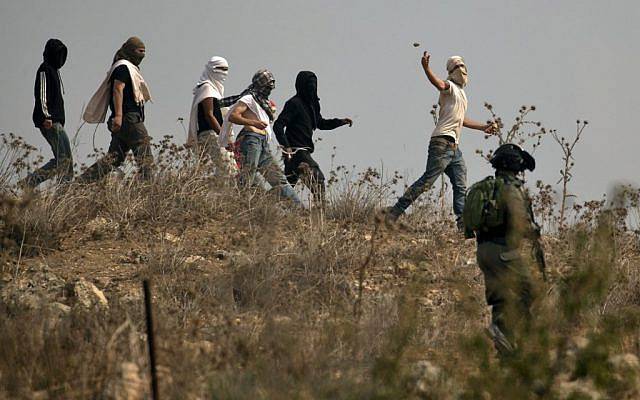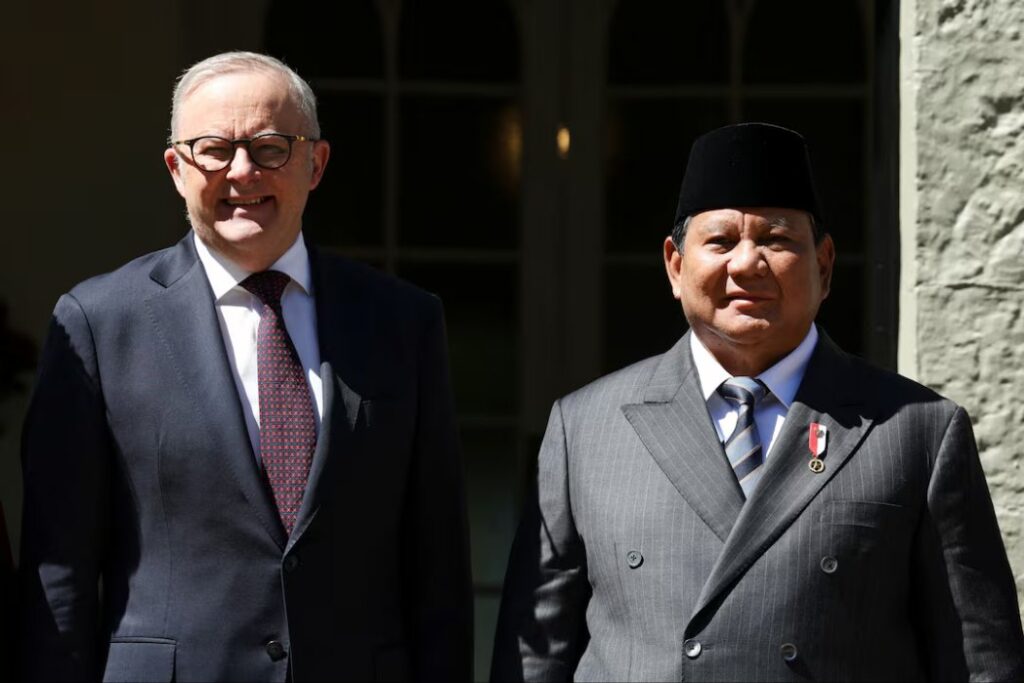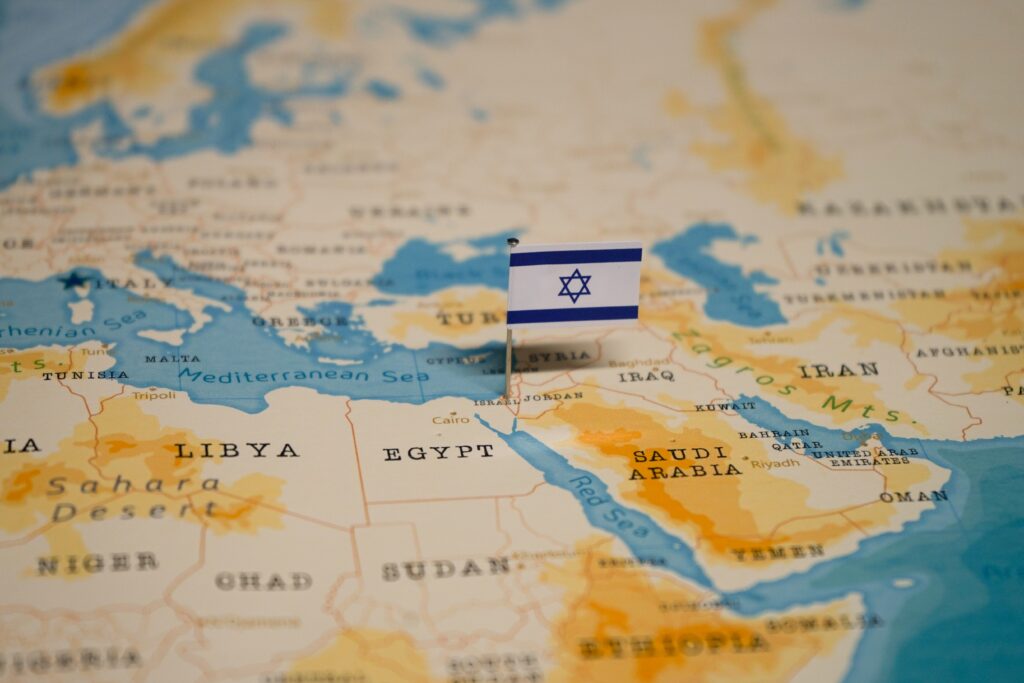UPDATES
“Juniper Oak”: A Message to Iran?
February 10, 2023 | AIJAC staff


Update 02/23 #02
This Update discusses the aftermath and political implications of the “Juniper Oak” US-Israeli military exercises that took place in late January, the largest such exercises ever.
We lead with Israeli strategic analyst, and former deputy director of Israel’s National Security Council, Col. (ret.) Dr. Eran Lerman. Lerman argues that “Juniper Oak” signals, and was designed to signal, the renewal of a credible military threat against Iran’s nuclear program, despite the denial by the exercise leaders that any particular country was targetted as a potential enemy in it. He also examines the history and growth of IDF cooperation with the US military, especially since 1991, and the recent changes in that relationship since the Abraham Accords were signed with some key Arab states. For this important introduction to the issue, CLICK HERE. Lerman also recommends a Washington Post column by David Ignatius on the signal to Iran in “Juniper Oak”, which can be read here.
Next up is Washington Institute for Near East Policy military affairs expert Michael Eisenstadt. He also says the exercise was in part a warning to Iran – and suggests some measures that can make future such exercises an even more effective warning. However, he goes on to argue that the US Biden Administration has failed to back up the exercise rhetorically with consistent messaging and policy that would genuinely reassure friends in the region and deter enemies – and Eisenstadt makes some suggestions about how the Administration can do this more effectively. For Eisenstadt’s valuable analysis in full, CLICK HERE.
Finally, we offer some comment and analysis on wider efforts to militarily contain and deter Iran from Washington-based expert Hussain Abdul-Hussain. Using the drone attack at an Isfahan Iranian military factory on Jan. 29, which was widely attributed to Israel, as a starting point, Abdul-Hussain surveys the wider pattern of attacks on military sites and hardware belonging to Iran and its proxies, of which this was the latest example. He finds these efforts “impressive” and says pro-Iranian terror groups would have vastly greater capabilities today if not for these attacks by whoever is doing them. For his complete discussion, CLICK HERE. Abdul-Hussein also had an insightful recent piece about what he learned about Israel growing up in Lebanon, and how he came to unlearn the hatred he was taught.
Readers may also be interested in…
- A good survey of the Israel-Iran “shadow war” of recent years from US expert Jonathan Schanzer.
- UAE analyst Salem Al Ketbi’s take on Juniper Oak.
- Cliff May on how the latest seizure of an Iranian arms shipment to Yemen underscores how Iran has become the “arsenal of tyranny.”
- Iran has just threateningly unveiled a large underground air and missile base. It has also just publicly displayed a ballistic missile with ‘Death to Israel’ written on it in Hebrew.
- Iranian state TV ran a series of programs featuring numerous Western Holocaust deniers in the lead-up to International Holocaust Remembrance Day on Jan. 27.
- In addition to its sale to Russia, Iran says it is now about to sell large numbers of drones to China. Meanwhile, China is reportedly giving surveillance technology to Iran to help it stifle the mass protest movement that has been ongoing there since September.
- Some examples from the many stories and comments now appearing at AIJAC’s daily “Fresh AIR” blog:
- Oved Lobel on the wider implications of the Iranian drone factory now being constructed in Russia.
- Earlier, Lobel commented on the apparent resistance of the ALP to considering proscribing the Islamic Revolutionary Guard Corps as a terrorist organisation, as many of Australia’s allies are doing or considering.
- Ran Porat discusses the likelihood of increased Palestinian terror, and strong Israeli counter-actions, in the coming weeks and months in a piece published by Monash University’s The Lens.
- An AIJAC slideshow on the Israeli rescue team and field hospital sent to Turkey to provide humanitarian aid in the wake of the deadly earthquake there on Monday. (Some amazing stories from their rescue efforts are here and here).
Juniper Oak
The largest ever US-Israel military exercise and the question of Israel’s unilateral strike capacity against Iran.
Eran Lerman
JNS, February 9, 2023

An MH-60R Seahawk helicopter, attached to Helicopter Maritime Strike Squadron (HSM) 48, prepares to land on the Arleigh Burke-class guided-missile destroyer USS Nitze (DDG 94), during exercise Juniper Oak 2023 (Photo: APFootage / Alamy Stock Photo)
In the last week of January, the United States and Israel conducted a joint military exercise, codenamed “Juniper Oak,” marking a milestone in the evolving cooperation between the Jewish state and U.S. Central Command (CENTCOM).
To those familiar with the bureaucratic handling of U.S.-Israel military cooperation, this all seems incredible. The Reagan administration created a series of regional commands, integrating its army, navy and air force under commanders with regional responsibilities; CENTCOM was formed in 1983 to cover the greater Middle East. Today its area of responsibility ranges from Egypt to Central Asia. At the time, Israel was mired in the First Lebanon War and subsequent occupation. Given that including Israel in CENTCOM would have sparked Arab hostility and reduced cooperation with Arab militaries, Israel was placed instead in the European Command (EUCOM).
True, in 1991, as Israel was being targeted by Saddam Hussein’s missiles in the First Gulf War, an ad-hoc liaison was established between CENTCOM (which led all operations against Saddam’s conquest of Kuwait) and the high command of the Israel Defense Forces to provide early warning and coordinate responses. But it soon waned. It was more than a decade later, as CENTCOM led the “Global War on Terror” after 9/11, that the utility of closer cooperation between CENTCOM and Israel became firmly established.
It involved contributions on a broad range of issues, from neutralizing roadside improvised explosive devices to intelligence tracking of terror groups. When Gen. Lloyd Austin took over command of CENTCOM (2013–2016), he built up a strong personal bond with Benny Gantz, chief of staff of the IDF (later the minister of defense), and various aspects of cooperation became routine. Still, given U.S. military sensitivities over Arab reservations, Israel remained in EUCOM, and its last joint exercise with the EUCOM was conducted in July 2021.
What finally led to Israel’s switch to CENTCOM—a decision made in the last year of Trump’s administration but only implemented in September 2021 under Biden’s presidency—were the diplomatic breakthroughs with the United Arab Emirates and Bahrain, which included an implicit message also from Saudi Arabia that a security role for Israel in the region might be a blessing, not a curse.
Juniper Oak was defined as a “Joint All-Domain Exercise” encompassing land, air, sea, space and cyber operations; as some have noted, this combination of all five dimensions of modern warfare is not easily achieved, let alone between two very different military establishments and professional cultures.
The U.S. forces participating—4,600 troops in all—comprised an aircraft carrier, the USS George H.W. Bush, and its task force, together with other naval assets; some 140 aircraft, including B-52 strategic bombers, fighter aircraft, helicopters and refueling tankers, in addition to those designated for future delivery to the Israeli Air Force; Army units, including HIMARS and MLRS rocket launchers, infantry and special forces.
No details were given as to the space and cyber components, but both countries have significant military assets in both domains (which can play a role, for example, in the non-kinetic suppression of enemy air defense).
Who, then, was the purported enemy of this exercise? In line with established policy, the official communiques from both countries were quite vague on that matter; the U.S. side made it clear that the physical targets struck in Israel’s Negev Desert during the exercise (more than 180,000 pounds of munitions) were not meant to simulate the specific assets of any country. But in unattributed background briefings and in comments by the Washington Post’s David Ignatius, it was all too clear that the exercise was indeed designed to simulate and prepare for a joint U.S.-Israel strike against Iran, specifically, a large-scale attack on its military nuclear project and the necessary disabling of Iran’s capacity to strike back, both on land and at sea.

Israeli PM Netanyahu (centre), along with Defence Minister Gallant (left) and IDF Chief of Staff Halevi (right), observe the Juniper Oak exercise electronically (Photo: Kobi Gideon/Israeli Government Press Office).
“Juniper Oak” signals the renewal of a credible military threat (which has, of course, its own acronym, CMT, in joint U.S.-Israel military jargon). Israeli Prime Minister Netanyahu and Defense Minister Gallant, hosted by the Israeli Air Force commander at the exercise command post, issued brief statements with a dual message, expressing appreciation for this new level of military cooperation between the two countries and reminding friend and foe alike that Israel still intends to retain its freedom of action to act unilaterally.
Despite the unity on display in “Juniper Oak,” Israeli decision-makers remain concerned about a very real possibility that the political echelon in Washington will not act against Iran at the moment of decision. Twelve years ago, Netanyahu, as prime minister, pushed for a unilateral strike capacity against Iran, precisely because that scenario concerns the Americans and motivates them to act. Thus, one question being discussed in detail in Israeli political circles today is where does Israel stand with its unilateral strike capacity. That question remains unresolved.
Col. (ret.) Dr. Eran Lerman, the former deputy director of Israel’s National Security Council, is the vice president of the Jerusalem Institute for Strategy and Security.
The Juniper Oak Military Exercise: Implications for Innovation, Experimentation, and U.S. Policy Toward Iran
by Michael Eisenstadt
Washington Insititute for Near East Policy
PolicyWatch 3698
Feb 1, 2023

Planes participating in the “Juniper Oak” exercise fly over the Israeli coast (Photo: U.S. Central Command Public Affairs)Brief Analysis
Last week’s large, combined exercise was intended to assure friends and deter adversaries, but both goals will ultimately depend on fixing a flawed policy toward Iran.
On January 23-26, the United States and Israel held their largest-ever bilateral military exercise, involving 7,900 personnel (6,400 Americans and 1,500 Israelis), 142 combat aircraft (100 American, 42 Israeli), twelve warships (the George H. W. Bush Carrier Strike Group and six Israeli vessels, including a submarine), and activities across all domains (sea, air, land, space, and cyber). The main goals of the exercise—named Juniper Oak—were to improve interoperability, demonstrate America’s ability to surge forces into the region while meeting commitments elsewhere, assure allies, deter adversaries (particularly Iran), and pave the way for additional large, complex exercises with Israel and other regional partners.
What It Was, and Wasn’t
Despite reports that the exercise simulated strikes on Iranian nuclear facilities, U.S. officials have denied this, and there is no reason to doubt these disclaimers. The B-52 bombers that participated in the exercise are not the aircraft for this mission, as they lack the ability to penetrate capable air defenses and deliver the only U.S. conventional bunker-buster munition (the GBU-57A/B Massive Ordnance Penetrator, or MOP) capable of damaging hardened, deeply buried nuclear facilities at Fordow or elsewhere.
That said, many of the missions exercised during Juniper Oak would be central to a major conflict involving Israel, Iran, and its proxies. This could lead Iranian decision-makers to conclude that they might also be facing American forces in the event of such a conflict—their nightmare scenario.
U.S. officials have indicated that Juniper Oak will be institutionalized and expanded. Washington intends to encourage other regional states to participate in similar large, complex exercises and will use the “fear of missing out” to draw them in. This will hopefully enable U.S. Central Command (CENTCOM) to flesh out the emerging regional security architecture that it has been building—which includes nascent air/missile defense and maritime surveillance components.
Future exercises should also incorporate the B-2 bomber, which would send a clear deterrent message given its ability to penetrate modern air defenses and drop the MOP. Moreover, the B-2 would convey this message without the need for fanfare (Tehran is generally more impressed by subtlety than swagger). If Washington is truly serious about not allowing Iran to get nuclear weapons (see below), then the B-2 should be part of future exercises in the Middle East, just as it routinely participates in exercises in the European and Indo-Pacific regions.
Successful Exercise, Flawed Policy
No series of military exercises—no matter how impressive—will assure friends and deter adversaries without changes to Washington’s flawed policy toward Iran. Meeting those goals will require the following:
Consistent messaging. The Biden administration has sent mixed messages regarding Iran’s nuclear program. In June 2021, the president vowed that “Iran will never get a nuclear weapon on my watch.” In July 2022, the U.S.-Israel Strategic Partnership Joint Declaration committed Washington “never to allow Iran to acquire nuclear weapons.” Biden repeated this commitment at a GCC+3 summit in Jeddah two days later, and again in his speech to the UN General Assembly in September.
On November 22, however, National Security Council strategic communications coordinator John Kirby noted that the United States was “not going to allow Iran to achieve a nuclear weapons capability”—a formulation he repeated on at least two other occasions (January 20 and January 27). And in a January 19 readout of National Security Advisor Jake Sullivan’s recent trip to Israel, NSC spokesperson Adrienne Watson underscored “the U.S. commitment to ensure Iran can never acquire a nuclear weapon”—in yet a third syntactically tortured version of this commitment.
Presidential statements are generally the last word when it comes to policy, but these more recent formulations by subordinates raise questions about whether U.S. policy has changed, since not allowing Iran to have a “nuclear weapon” is very different from not allowing Iran to have a “nuclear weapons capability.” This inconsistency may confirm the belief held by many allies and partners that the United States lacks a well-thought-out policy, hinting at disarray that might encourage Tehran to further test Washington by intensifying its nuclear activities.

An Administration problem with mixed messaging on Iran? US President Joe Biden, with US Secretary of State Antony Blinken and US Secretary of Defense Lloyd Austin at a White House press conference on Jan. 25 (Photo: dpa picture alliance / Alamy Stock Photo).
Capability and credibility. Juniper Oak aimed in part to demonstrate America’s power projection capabilities and its capacity to focus on the Middle East while managing a war in Europe and tensions in the Indo-Pacific region. In this regard, the exercise succeeded. Yet Washington’s friends and adversaries do not doubt its demonstrated ability to project power—they doubt its commitment and resolve. In particular, U.S. credibility has been undermined by a failure to respond more assertively to attacks on U.S. targets and partners in the region.
Although this problem long preceded President Biden, his administration has responded overtly only three times to scores of drone, rocket, and improvised explosive device attacks on U.S. personnel and interests in Iraq and Syria (though attacks in Iraq have declined precipitously in the past six months). Officials claim that the administration’s responses may not always be visible, yet its acknowledged actions have telegraphed ambivalence and apprehension. Indeed, the U.S. garrison at al-Tanf, Syria, was attacked two days before the start of Juniper Oak, and there is no sign of any U.S. response since then. Even a successful gray zone strategy that relies largely on covert or unacknowledged activities should occasionally employ overt action to demonstrate resolve.
Setting limits. One way to address policy challenges related to messaging and credibility is for Washington to define and enforce red lines regarding Iran’s regional and nuclear activities. Policymakers generally seek to avoid commitments in order to preserve options, and U.S. officials have often been loath to set red lines on Iran. Yet drawing them can be useful if Washington is committed to them, and if they enjoy bipartisan and public support.
Influencing Tehran to tamp down attacks against U.S. personnel and interests may not necessarily require formally defined red lines, however; U.S. limits can be conveyed by actions. Nonlethal attacks should be met with nonlethal responses that impose significant material costs on Iran, while lethal attacks should elicit asymmetric lethal responses to inflict costs that Tehran is unwilling to sustain. In both cases, responses should be conducted mainly through gray zone activities.
In the nuclear domain, Washington does need to draw a red line to halt Tehran’s ongoing fissile material buildup. Specifically, it should ramp up sanctions enforcement and signal that uranium enrichment beyond 60 percent will cause the United States to disrupt these activities and impose heavy costs on Iran (for more on the technical aspects of enrichment, see The Washington Institute’s Iran Nuclear Explainer). In tandem with exercises like Juniper Oak, this approach would telegraph Washington’s greater willingness to incur risk in countering the Islamic Republic’s problematic activities.
If policymakers are unwilling to draw a clear nuclear red line, then they need to explain to allies and partners how they plan to halt or manage the consequences of Iran’s ongoing fissile material buildup and possible future attempts to produce weapons-grade uranium (i.e., 90 percent enrichment). They also need to explain whether U.S. policy is to prevent Iran from acquiring a nuclear weapons capability or a weapon—and how they will accomplish either objective. At any rate, military exercises like Juniper Oak need to be part of a larger, whole-of-government shaping strategy that employs all the instruments of national power to assure friends and deter Iran.
Conclusion
For decades, U.S. policy has been hobbled by an aversion to risk-taking and experimentation when using the military instrument to deter and disrupt Iran’s regional and nuclear activities. Yet necessity is the mother of invention, and the shortcomings of the current policy may spur a change of approach.
The United States has repeatedly shown an ability to innovate when dealing with Iran. For example, nearly two decades ago it partnered with Israel to pioneer the use of offensive cyber operations (e.g., Stuxnet) that delayed the nuclear program and bought time for diplomacy; over a decade ago it broke with previous sanctions policy to impose severe restrictions on Iran’s financial activities and oil exports that generated unprecedented pressure; and recently it has been experimenting with new military technologies and operational approaches (e.g., networked unmanned platforms, more flexible force deployment options, new regional partnerships) to compensate for reduced force levels in the region.
Yet when it comes to the limited use of force, Washington has often been self-deterred by understandable but overstated fears of a miscalculation leading to “all-out war” with Iran. It has thus denied itself the opportunity to become more proficient in gray zone activities, and to shape Tehran’s choices and constrain its activities by military means. The result is a superpower with a stunted conception of how to use the military instrument in support of statecraft.
As an example of innovation in the conduct of large, complex, combined exercises, Juniper Oak represents a break from this past. Hopefully, it will also stimulate other forms of experimentation by the Defense Department and CENTCOM that will enable policymakers to test and shed outdated or erroneous conceptions, and permit the kind of managed risk-taking and operational learning that may produce a more successful Iran policy.
Michael Eisenstadt is the Kahn Fellow and director of the Military and Security Studies Program at The Washington Institute.
Clipping the wings of Iran and its militias
Hussain Abdul-Hussain
Arab News, February 5, 2023

Screengrab from a video posted on October 31, 2022, to the IRGC’s Telegram channel, shows what seems to be an Iranian attack drone hangar. (Photo: Middle East Media Research Institute)
The recent drone attack on an Iranian military compound in Isfahan was not the first of its kind and is unlikely to be the last. It was one of many that have hit Iranian arms depots and convoys across the region, including in Syria and Lebanon. Just hours after the Jan. 29 attack in Iran, for example, trucks that had crossed from Iraq into Syria were also reportedly attacked with drones. While many see these strikes as part of an undeclared war on Iran’s nuclear program, they should be viewed more as a regional counterterrorism effort.
Israel has rarely admitted carrying out these attacks, but it is widely understood that it is behind them and that the goal is to prevent Iran from building up the asymmetric war capabilities of its militias. According to US law, “premeditated, politically motivated, violence,” committed by “subnational groups (militias) against noncombatants,” are acts of terrorism. This legal definition makes it hard to argue against the fact that Israel is helping combat terrorism across the Middle East.
Iran, for its part, seems to have been too embarrassed to admit the extent of the damage these strikes have caused. Tehran has downplayed them, while its militias have often denied that they even took place.
In Syria, Bashar Assad’s weak grip on power has forced Israel to act with a high frequency to prevent Iran from building a military infrastructure in Syria’s southwest — a region that shares a border with Israel. At first, the Assad regime tried to hide the Israeli strikes, mainly through claiming that the explosions were caused by an electrical short circuit, an explanation that invited widespread sarcasm. As it became known that Israel was targeting Iranian militias in Syria, the Assad regime stopped commenting. Israel, for its part, started to open up about the strikes, without elaborating on any one of them in particular.
In Lebanon, things are different. Iran-backed Hezbollah rules with an iron fist and an overt Israeli strike might ignite a full-scale war that neither side wants. Hence, bombings targeting Hezbollah’s weapons caches have remained mysterious.
Israel has long accused Hezbollah of storing weapons in Lebanon’s civilian neighborhoods. During the 2006 war between the two sides, Israel hit Lebanese houses, saying that it was responding to spots from where Hezbollah had launched missiles.
In September 2018, Israel released photos of facilities located close to Beirut airport, where Hezbollah “converted regular missiles into precision-guided ones.” Two months later, Israel “exposed and destroyed” a series of tunnels dug “from within civilian houses in Lebanon into Israel.” These were the only times when Israel talked publicly about Hezbollah’s military sites, until December, when Israel threatened “to strike the Beirut airport over Iran’s arms shipments.”

An image published by Israel in 2020 purporting to show a Hezbollah missile factory in a civilian area of Beirut, near major gas infrastructure. (Photo: Israeli PM’s Office).
In September 2020, a weapons depot exploded in the southern Lebanese village of Ain Qana. The pro-Iran militia borrowed one of Assad’s favorite excuses, blaming an electrical short.
Since December 2021, a series of explosions have rocked Lebanon. One was heard in Janta, a Hezbollah stronghold in the east. Two weeks later, locals near the southern village of Homin Al-Fawqa were woken by an explosion. Six days later, a bang was heard near the coastal city of Tyre.
Hezbollah reacted the same way to all these blasts. It sealed off the area, sent in its own ambulances to transport the dead and the injured to undisclosed medical facilities, and invented cover stories. In Homin Al-Fawqa, Hezbollah said an overheated generator detonated its diesel reservoir. The last of the explosions went off last week, again in Homin Al-Fawqa, where a Hezbollah “social services” office was hit.
Hezbollah is not the only pro-Iran militia in Lebanon to see its arms caches go up in flames. In December 2021, an explosion rocked a Hamas weapons depot at the Burj Shemali Palestinian refugee camp, near Tyre. Hamas also blamed, you guessed it, an electrical short. A day later, the Palestinian organization, which is designated as a terrorist group by the US, Israel and Europe, held a funeral for its militants killed in that “short.”
Like Iran, Hezbollah has been suppressing news about explosions to avoid a war that could ravage a country that is already falling apart. The bombings have also shown that Iran and its militias are heavily infiltrated by foreign intelligence agencies and that they have been irresponsibly storing arms and ammunition in civilian neighborhoods.
Whoever has been continuously clipping the wings of the pro-Iran militias has been doing so impressively, selecting secret targets and bombing them discreetly when needed and less so when circumstances — like in Syria — permit.
Without the ongoing attacks, like the one on Isfahan and the airstrikes that followed on convoys that crossed from Iraq into Syria, pro-Iran terrorist groups would have improved their capabilities enormously. Not long ago, the US was the one that led such counterterrorism, but it has now given up on the role. Israel, or whoever is responsible for bombing Iran and its militias, has stepped up to fill the American void.
Hussain Abdul-Hussain is a research fellow at the Foundation for Defense of Democracies, a Washington, DC-based, nonpartisan research institute focusing on national security and foreign policy. Follow him on Twitter: @hahussain.
Tags: IDF, Iran, Israel, Middle East, United States





